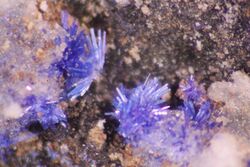Chemistry:Chanabayaite
| Chanabayaite | |
|---|---|
 | |
| General | |
| Category | Organic mineral |
| Formula (repeating unit) | Cu2(N3C2H2Cl(NH3,Cl,H2O,[])4 |
| Crystal system | Orthorhombic |
| Crystal class | Dipyramidal (mmm) H-M symbol: (2/m 2/m 2/m) |
| Space group | Imma |
| Unit cell | a = 19.48, b = 7.21, c = 11.999 [Å] (approximated); Z = 4 |
| Identification | |
| Color | Blue |
| Crystal habit | Prisms (imperfect); radial aggregates |
| Cleavage | (001), perfect; (100) and (010), imperfect |
| Tenacity | Brittle |
| Mohs scale hardness | 2 |
| Density | 1.48 (measured) |
| Pleochroism | Deep blue to pale blue with gray hue (strong) |
| References | [1][2][3] |
Chanabayaite is the first recognized triazolate mineral, having the formula Cu2(N3C2H2Cl(NH3,Cl,H2O,[])4.
Minor iron admixture is also present.[2] It is also one of a few currently known minerals containing ammine groups, including also ammineite, joanneumite and shilovite.[5][6][7] All the minerals are rare and were found in a single guano deposit in Chile, called Pabellón de Pica.[3] A similar natural phase, formula NaCu2Cl3[N3C2H2]2[NH3]2•4H2O, likely a precursor of chanabayaite, is described by Zubkova et al. 2016.[8]
Crystal structure
The main features of the crystal structure of chanabayaite are:[2]
- copper forms octahedra, part of which share corners
- 1,2,4-triazolate anions link the octahedra
Association
Chanabayaite coexists with halite, joanneumite, nitratine, salammoniac and paragenetically-unrelated chalcopyrite. Chalcopyrite is present in an amphibole- and plagioclase-bearing gabbro, that contacts the guano deposit.[2]
Formation
Three suggested processes account for the formation of chanabayaite:[2]
- leaching of sodium from the precursor phase
- leaching of chlorine from the precursor phase
- partial dehydratation of the precursor phase
References
- ↑ Mineralienatlas
- ↑ 2.0 2.1 2.2 2.3 2.4 Chukanov, N.V., Zubkova, N.V., Möhn, G., Pekov, I.V., Pushcharovsky, D.Yu., and Zadov, A.E., 2015. Chanabayaite, Cu2(N3C2H2Cl(NH3,Cl,H2O,[])4, a new mineral containing triazolate anion. Geology of Ore Deposits 57(8), 712-720.
- ↑ 3.0 3.1 "Chanabayaite: Chanabayaite mineral information and data". http://www.mindat.org/min-43945.html. Retrieved 2016-03-10.
- ↑ Warr, L.N. (2021). "IMA–CNMNC approved mineral symbols". Mineralogical Magazine 85 (3): 291–320. doi:10.1180/mgm.2021.43. Bibcode: 2021MinM...85..291W.
- ↑ "Ammineite: Ammineite mineral information and data". http://www.mindat.org/min-38895.html. Retrieved 2016-03-10.
- ↑ "Joanneumite: Joanneumite mineral information and data". http://www.mindat.org/min-42755.html. Retrieved 2016-03-10.
- ↑ "Shilovite: Shilovite mineral information and data". http://www.mindat.org/min-46139.html. Retrieved 2016-03-10.
- ↑ Zubkova, N.V., Chukanov, N.V., Pekov, I., and Pushcharovsky, D., 2016. The crystal structure of the natural 1,2,4-triazolate compound NaCu2Cl3[N3C2H2]2[NH3]2•4H2O. Zeitschrift für Kristallographie - Crystalline Materials 231(1), 47–53.
 |

